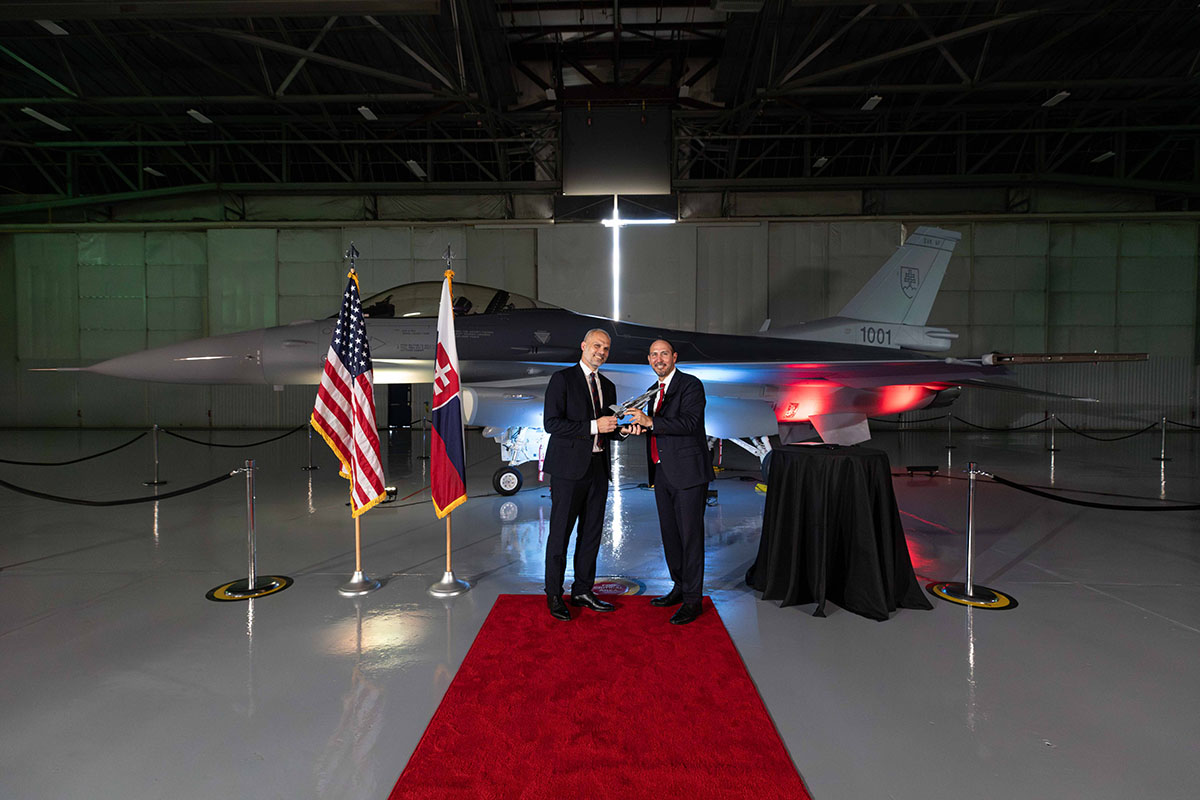In a momentous event on September 6, Lockheed Martin unveiled Slovakia’s first F-16C Block 70 during a formal ceremony hosted at the company’s production facility in Greenville, South Carolina.
The single-seat fighter aircraft, marked with service registration number 1001, was showcased by Slovak Defense Minister Martin Sklenár and other senior Slovakian officials who attended the event.
Following in the footsteps of Bahrain, Bratislava is preparing to introduce this new F-16 model into its fleet, with a total commitment of 14 F-16 aircraft — comprising 12 single-seat fighter jets and a pair of twin-seat trainers.
The country is set to become the first European nation to acquire the latest and highly advanced variant of the Fighting Falcon, Lockheed Martin said in a statement.
The first aircraft is scheduled to initiate flight trials in November, paving the way for deliveries to Slovakia, which are expected to kick off in the second quarter (Q2) of 2024.

Slovakia officially committed to its F-16 acquisition in December 2018 through a procurement contract valued at EUR 1.6 billion (equivalent to US$1.8 billion).
This comprehensive agreement also encompassed the supply of Raytheon AIM-120C7 Advanced Medium-Range Air-to-Air Missiles (AMRAAMs), AIM-9X Sidewinder air-to-air missiles, and training and support provisions.
“These F-16s will enable the Slovak Air Force to stay ahead of threats in the region and be part of the allied mission in Europe, NATO, and around the world,” said OJ Sanchez, vice president of Integrated Fighter Group at Lockheed Martin.
“This jet represents the strong partnership between Lockheed Martin, the United States, the Slovak Republic, and allies,” Sanchez added.
A total of six countries have opted for the Block 70/72 aircraft. This includes Bahrain, Slovakia, Bulgaria, Taiwan, Jordan, and an unspecified customer.
Earlier this year, in March, the Royal Bahraini Air Force took delivery of Bahrain’s first F-16 Block 70 aircraft, a significant event that transpired at Lockheed Martin’s facilities in Greenville, South Carolina.
Slovakia’s acquisition of this jet serves as a replacement for its previously retired RAC MiG-29s. In March 2023, Slovakia generously donated 13 MiG-29 fighters to Ukraine.
F-16 Block 70 Aircraft
The F-16 Block 70/72, also known as the F-16V, is the most advanced and highly sought-after version of this fighter aircraft. This fourth-generation multirole aircraft is primarily designed for export customers.
Key features of the Block 70/72 include advanced avionics, an APG-83 AESA radar, a modernized cockpit, conformal fuel tanks, an Automatic Ground Collision Avoidance System, a center pedestal display providing tactical imagery on a high-resolution 6×8-inch screen, and an extended structural service life of 12,000 hours.
Lockheed Martin built the F-16V as an advanced fighter option that could capitalize on its existing production capabilities and global support network.
According to the manufacturer, structural and capability enhancements ensure that the F-16 can remain operational and effective up to and beyond 2070, representing a 50% increase in the aircraft’s service life compared to previous production models.
The price of the F-16 Block 70/72 can fluctuate based on its configuration and the equipment included, but it is anticipated to fall within the range of US$50 million to US$70 million per aircraft.
This jet is also well-equipped for advanced air-to-ground missions, featuring enhanced support for multiple weapons, targeting systems, and advanced weapon capabilities.
Furthermore, the F-16 Block 70/72 boasts enhanced aircraft survivability thanks to low observable technologies like integrated forward-looking infrared (FLIR), ram air turbine door actuators, and CWIS hard points.
Additionally, this latest iteration of the F-16 benefits from increased engine power, providing greater mission flexibility and responsiveness in various operational scenarios.
While Lockheed Martin has encountered production challenges for this aircraft in recent years, the company has announced plans to significantly ramp up the production rate throughout 2023.
In 2017, Lockheed Martin decided to shift the production of the F-16 from its large manufacturing facility in Fort Worth, Texas, to the comparatively smaller Greenville plant.
This move was prompted by the company’s recognition of the need for an additional factory site dedicated to the Viper (F-16).
This decision was also influenced by the significant and fast-paced expansion of F-35 production in Fort Worth, which had become the top priority within the company’s manufacturing operations.
Consequently, establishing a separate production facility for the F-16 allowed Lockheed Martin to manage its production capabilities better and meet the growing demand for both aircraft models more effectively.
- Contact the author at ashishmichel(at)gmail.com
- Follow EurAsian Times on Google News